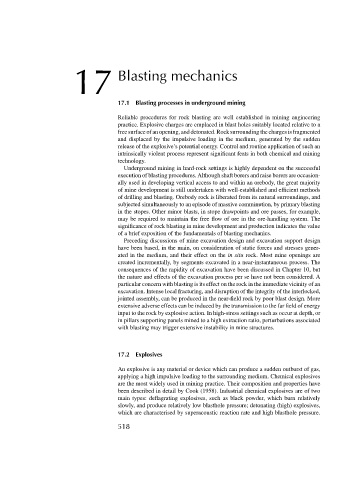Page 536 - Rock Mechanics For Underground Mining
P. 536
17 Blasting mechanics
17.1 Blasting processes in underground mining
Reliable procedures for rock blasting are well established in mining engineering
practice. Explosive charges are emplaced in blast holes suitably located relative to a
free surface of an opening, and detonated. Rock surrounding the charges is fragmented
and displaced by the impulsive loading in the medium, generated by the sudden
release of the explosive’s potential energy. Control and routine application of such an
intrinsically violent process represent significant feats in both chemical and mining
technology.
Underground mining in hard-rock settings is highly dependent on the successful
execution of blasting procedures. Although shaft borers and raise borers are occasion-
ally used in developing vertical access to and within an orebody, the great majority
of mine development is still undertaken with well-established and efficient methods
of drilling and blasting. Orebody rock is liberated from its natural surroundings, and
subjected simultaneously to an episode of massive comminution, by primary blasting
in the stopes. Other minor blasts, in stope drawpoints and ore passes, for example,
may be required to maintain the free flow of ore in the ore-handling system. The
significance of rock blasting in mine development and production indicates the value
of a brief exposition of the fundamentals of blasting mechanics.
Preceding discussions of mine excavation design and excavation support design
have been based, in the main, on consideration of static forces and stresses gener-
ated in the medium, and their effect on the in situ rock. Most mine openings are
created incrementally, by segments excavated in a near-instantaneous process. The
consequences of the rapidity of excavation have been discussed in Chapter 10, but
the nature and effects of the excavation process per se have not been considered. A
particular concern with blasting is its effect on the rock in the immediate vicinity of an
excavation. Intense local fracturing, and disruption of the integrity of the interlocked,
jointed assembly, can be produced in the near-field rock by poor blast design. More
extensive adverse effects can be induced by the transmission to the far field of energy
input to the rock by explosive action. In high-stress settings such as occur at depth, or
in pillars supporting panels mined to a high extraction ratio, perturbations associated
with blasting may trigger extensive instability in mine structures.
17.2 Explosives
An explosive is any material or device which can produce a sudden outburst of gas,
applying a high impulsive loading to the surrounding medium. Chemical explosives
are the most widely used in mining practice. Their composition and properties have
been described in detail by Cook (1958). Industrial chemical explosives are of two
main types: deflagrating explosives, such as black powder, which burn relatively
slowly, and produce relatively low blasthole pressure; detonating (high) explosives,
which are characterised by superacoustic reaction rate and high blasthole pressure.
518

